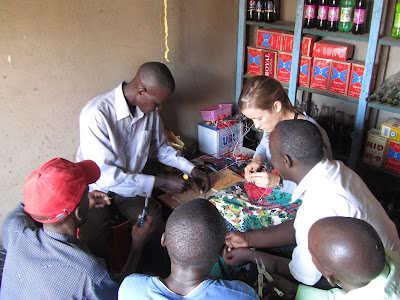About twenty four hours ago, Julian's flight to Dubai out of Entebbe International Airport took off. I've got another six weeks or so (until August 6th) on the ground here, so the project is far from over, but we'll miss him loads (bonus points if you get the power pun in there)!
One of his last days this past week, we arrived at work to discover the above beautiful sign sitting in their shop (design courtesy of Obama Jr., whose 22nd birthday is today!). One of the things when we first spoke about branching with the Lwemodde Youth Group was sort of the question of whether or not they wanted to create a brand for themselves, and we showed them the front of my notebook: our project name with a stick-figure sun.
 At which point Obama was off and away, designing not a name for their shop, but a distinctive sign with which to brand it. Several iterations of this were drawn, and Julian and I were kind of expecting to have a day on which we painted a sign and generally decorated to advertise the Lwemodde shop as an internet cafe and the Malembo shop as a micro-grid.
At which point Obama was off and away, designing not a name for their shop, but a distinctive sign with which to brand it. Several iterations of this were drawn, and Julian and I were kind of expecting to have a day on which we painted a sign and generally decorated to advertise the Lwemodde shop as an internet cafe and the Malembo shop as a micro-grid.
However it's obvious that we were beaten to the punch, and showed up on one of Julian's last days to find this super snazzy sign. It was pretty exciting in a selfish way, seeing their sign with their services and name paired with the name we thought of during our first week in Uganda. If nothing else, at least Julian can leave Uganda knowing that we have made a mark! Mission accomplished.
But really: I'll miss Julian; the excitement and proactiveness of the Lwemodde Youth Group never ceases to amaze me, and if you're driving along Ddimo Road, now you know where to stop for some high quality phone repair, hair dressing, agricultural advice, and (crossing our fingers!) internet/computer services. Here's to another six weeks!
One of his last days this past week, we arrived at work to discover the above beautiful sign sitting in their shop (design courtesy of Obama Jr., whose 22nd birthday is today!). One of the things when we first spoke about branching with the Lwemodde Youth Group was sort of the question of whether or not they wanted to create a brand for themselves, and we showed them the front of my notebook: our project name with a stick-figure sun.
 At which point Obama was off and away, designing not a name for their shop, but a distinctive sign with which to brand it. Several iterations of this were drawn, and Julian and I were kind of expecting to have a day on which we painted a sign and generally decorated to advertise the Lwemodde shop as an internet cafe and the Malembo shop as a micro-grid.
At which point Obama was off and away, designing not a name for their shop, but a distinctive sign with which to brand it. Several iterations of this were drawn, and Julian and I were kind of expecting to have a day on which we painted a sign and generally decorated to advertise the Lwemodde shop as an internet cafe and the Malembo shop as a micro-grid.However it's obvious that we were beaten to the punch, and showed up on one of Julian's last days to find this super snazzy sign. It was pretty exciting in a selfish way, seeing their sign with their services and name paired with the name we thought of during our first week in Uganda. If nothing else, at least Julian can leave Uganda knowing that we have made a mark! Mission accomplished.
But really: I'll miss Julian; the excitement and proactiveness of the Lwemodde Youth Group never ceases to amaze me, and if you're driving along Ddimo Road, now you know where to stop for some high quality phone repair, hair dressing, agricultural advice, and (crossing our fingers!) internet/computer services. Here's to another six weeks!













































